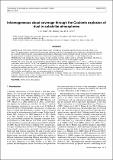Files in this item
Inhomogeneous cloud coverage through the Coulomb explosion of dust in substellar atmospheres
Item metadata
| dc.contributor.author | Stark, Craig Ronald | |
| dc.contributor.author | Helling, Christiane | |
| dc.contributor.author | Diver, D. A. | |
| dc.date.accessioned | 2015-05-19T11:32:16Z | |
| dc.date.available | 2015-05-19T11:32:16Z | |
| dc.date.issued | 2015-07 | |
| dc.identifier | 188639537 | |
| dc.identifier | 41049fef-a6fc-462a-9b03-577258d6db56 | |
| dc.identifier | 84933521588 | |
| dc.identifier | 000358877100053 | |
| dc.identifier.citation | Stark , C R , Helling , C & Diver , D A 2015 , ' Inhomogeneous cloud coverage through the Coulomb explosion of dust in substellar atmospheres ' , Astronomy & Astrophysics , vol. 579 , A41 . https://doi.org/10.1051/0004-6361/201526045 | en |
| dc.identifier.issn | 0004-6361 | |
| dc.identifier.uri | https://hdl.handle.net/10023/6663 | |
| dc.description.abstract | Context. Recent observations of brown dwarf spectroscopic variability in the infrared infer the presence of patchy cloud cover. Aims. This paper proposes a mechanism for producing inhomogeneous cloud coverage due to the depletion of cloud particles through the Coulomb explosion of dust in atmospheric plasma regions. Charged dust grains Coulomb-explode when the electrostatic stress of the grain exceeds its mechanical tensile stress, which results in grains below a critical radius a < aCoulcrit being broken up. Methods. This work outlines the criteria required for the Coulomb explosion of dust clouds in substellar atmospheres, the effect on the dust particle size distribution function, and the resulting radiative properties of the atmospheric regions. Results. Our results show that for an atmospheric plasma region with an electron temperature of Te = 10 eV (≈ 105 K), the critical grain radius varies from 10-7 to 10-4 cm, depending on the grains’ tensile strength. Higher critical radii up to 10-3 cm are attainable for higher electron temperatures. We find that the process produces a bimodal particle size distribution composed of stable nanoscale seed particles and dust particles with a ≥ aCoulcrit , with the intervening particle sizes defining a region devoid of dust. As a result, the dust population is depleted, and the clouds become optically thin in the wavelength range 0:1 - 10 μm, with a characteristic peak that shifts to higher wavelengths as more sub-micrometer particles are destroyed. Conclusions. In an atmosphere populated with a distribution of plasma volumes, this will yield regions of contrasting radiative properties, thereby giving a source of inhomogeneous cloud coverage. The results presented here may also be relevant for dust in supernova remnants and protoplanetary disks. | |
| dc.format.extent | 13 | |
| dc.format.extent | 1574119 | |
| dc.language.iso | eng | |
| dc.relation.ispartof | Astronomy & Astrophysics | en |
| dc.subject | Brown dwarfs | en |
| dc.subject | Dust | en |
| dc.subject | Plasma | en |
| dc.subject | QB Astronomy | en |
| dc.subject | QC Physics | en |
| dc.subject | NDAS | en |
| dc.subject.lcc | QB | en |
| dc.subject.lcc | QC | en |
| dc.title | Inhomogeneous cloud coverage through the Coulomb explosion of dust in substellar atmospheres | en |
| dc.type | Journal article | en |
| dc.contributor.institution | University of St Andrews. School of Physics and Astronomy | en |
| dc.identifier.doi | 10.1051/0004-6361/201526045 | |
| dc.description.status | Peer reviewed | en |
This item appears in the following Collection(s)
Items in the St Andrews Research Repository are protected by copyright, with all rights reserved, unless otherwise indicated.

